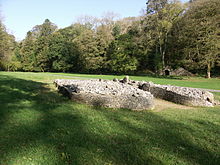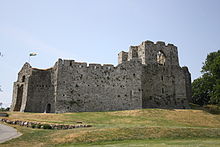Gower Peninsula
| Gower Peninsula | ||
 Rhossili Beach |
||
| Geographical location | ||
|
|
||
| Coordinates | 51 ° 36 ′ N , 4 ° 8 ′ W | |
| Waters 1 | Swansea Bay ( Bristol Channel ) | |
| Waters 2 | Loughor - estuary | |
| length | 30 km | |
| surface | 188 km² | |
The Gower Peninsula ( Welsh Penrhyn Gŵyr ) is a peninsula on the south coast of Wales in Great Britain . Along with Snowdonia, the peninsula is one of the most famous tourist regions in Wales.
geography
The peninsula protruding into the Bristol Channel is bounded in the east by the mouth of the Tawe and in the west by the mouth of the River Loughor , the entire coastline is about 57 km long. The peninsula consists of a highland, which is divided into a southern and northern half by the 180 m high mountain range Cefn Bryn . The highland slopes steeply to the sea, especially on the south and west coast. The highest point of the peninsula is the 193 m high beacon of Rhossili Down in the west of the peninsula, here the peninsula ends in the rocks of Worm's Head . The cliff has numerous bays with sandy beaches such as Langland, Caswell and Three Cliffs Bay . In the north, the highlands at Llanrhidian slopes down to the present salt marshes and the sandbanks Llanrhidian and Whiteford Sands at the mouth of the River Loughor.
The main town of the peninsula is the city of Swansea in the east, which is followed by the seaside resort of Mumbles in the southwest . On the peninsula itself there are only small villages like Rhossili , Pennard , Oxwich , Bishopston , Parkmill or Cwm Ivy .
nature
Large parts of the peninsula are used agriculturally as arable or pasture areas. In addition, dense oak forests cover the peninsula. A third of the peninsula is protected as a National Nature Reserve or a Site of Special Scientific Interest , and the coast is classified as a Heritage Coast .
economy
Swansea is an economic center of Wales, but the once dominant metal industry is going through a structural change. The peninsula is still dominated by agriculture, plus tourism. The National Trust owns parts of the coast, especially at Rhossili. Rhossili Bay Beach was voted the most beautiful beach in Great Britain by the visitors of Tripadvisor in 2014 and is also counted among the most beautiful beaches worldwide.
history
Paleolithic and Neolithic
The oldest settlement track on Gower is at Rhossili found hand ax , whose age is estimated at about 125,000 years. The next finds of human presence are around 30,000 years old, above all the Red Lady of Paviland , a skeleton of a young man intricately buried in a cave. After that, Gower was frozen like large parts of Europe , so that the next human traces, bones and flints found at Paviland and Cathole, are around 15,000 years old. After the final end of the Ice Age, early Neolithic farmers erected several megalithic tombs , including Arthur's Stone , which dates back to around 2500 BC. The Sweyne's Howes , Penmaen Burrows and above all Park Cwm , which existed from about 3800 to 3500 BC. BC originated. A number of menhirs , as in Burry, were also erected in prehistoric times.
From Roman times to the 11th century
During Roman rule around 75 AD, the Leucarum fort was built near today's Loughor to secure the transition over the River Loughor. There are also numerous other traces of Roman rule such as the remains of a villa that were discovered under the medieval All Saints church in Oystermouth. After the end of Roman times, Gower remained settled by Celtic Welsh people. The Welsh Commote Gwyr stretched across the peninsula and moorland between the Loughor and Tawe rivers and was subject to the Kingdom of Dyfed and later Deheubarth .
Norman conquest and domination
From around 1095, the Norman conquest began with raids on the peninsula. In 1106, the Norman Henry de Beaumont began the conquest of Gower. As the center of his new rule, he built Swansea Castle , next to a number of simple earth and wood fortifications such as Pennard , Penrice and Loughor Castle to secure the Norman and Anglo-Norman rule. The fertile peninsula was also the destination of English settlers. The Borough Swansea, which received a charter before 1184 , developed around Swansea Castle . Despite several Welsh uprisings and attacks, in which during the uprising from 1136 the Anglo-Normans suffered a heavy defeat in an unknown location in north Gower, Gower remained an Anglo-Norman rule of the Welsh Marches . After it fell to the crown in 1184, King Johann Ohneland gave it to William de Braose in 1203 . With interruptions it remained in the possession of his descendants until 1324. During the wars of the Welsh prince Llywelyn from Iorwerth against the English, Gower was plundered and devastated by the Welsh in 1212 and 1215. In 1217 the Welshman Rhys Gryg took over the rule, but three years later he had to give Gower back to John de Braose , who was a son-in-law of Llywelyn from Iorwerth. Because of the ambivalent attitude of William de Braose, 2nd Baron Braose , who had no male descendants, there was an inheritance dispute from 1319, which in 1322 triggered the Despenser War , an uprising of the Marcher Lords against the English King Edward II .
Late Middle Ages
After the fall of King Edward II, Gower fell in 1327 to John Mowbray , a grandson of the last Braose. This and the subsequent Lords of Gower visited the rule only sporadically, as they owned other extensive estates in England. Mowbray's reign was successfully challenged in 1354 by William Beauchamp, a descendant of the Lords of Gower of the 12th century, but in 1397 Gower fell back to the Mowbray family after another trial and stayed with them until 1469. During the rebellion of Owain Glyndŵr was the Much of Gower was in the hands of the Welsh rebels between 1403 and 1405, before the English could crush the rebellion. During the Wars of the Roses the House of Lancaster on Gower had numerous supporters. King Edward IV of the House of York therefore forgave Gower to his most important Welsh ally, William Herbert, during the minority of John Mowbray, 4th Duke of Norfolk in 1462 . Mowbray finally left Herbert Gower in 1468, which after the Wars of the Roses remained in the possession of his descendants until it became part of Glamorgan in 1535 through the laws for the incorporation of Wales .
Modern times
While industrialization began in Swansea from the 17th century, the rest of the peninsula remained largely rural. The poorly developed peninsula lost its importance and castles and mansions such as Oxwich and Weobley Castle fell into disrepair. During the English Civil War there was no significant fighting in Gower, after the victory of the parliamentary troops, the already dilapidated castles Oystermouth and Swansea Castle were finally razed . In the 18th and 19th centuries, limestone was mined on the cliffs at Port Eynon and in quarries inland, some of which was shipped to south-west England. From 1804 to 1805 a horse-drawn tram was built between Oystermouth and Swansea for freight traffic , which was also used for regular passenger traffic from 1807. This makes it the world's first rail line for passenger transport. The seaside resort of Mumbles was built on the southeast coast . In 1956, Gower was the first region in Great Britain to be protected as an Area of Outstanding Natural Beauty . Politically, Gower remained a rural district until 1974 when Swansea became part of Preserved County West Glamorgan . In 1996 West Glamorgan was split up, Gower became part of the Swansea Principal Area .
See also
literature
- Diane M. Williams: Gower. A Guide to ancient and historic monuments on the Gower peninsula . Cadw, Cardiff 1998. ISBN 1-85760-073-8
Web links
- Swansea Bay (Official City & County of Swansea Tourism Site)
- The Gower (tourist website)
Individual evidence
- ↑ BBC South Wales: Rhossili Bay retains best UK beach title and comes ninth in world league. Retrieved June 12, 2015 .
- ↑ Swansea Museum: Mumbles Train. Retrieved June 11, 2015 .
- ↑ City and County of Swansea: Gower Area of Outstanding Natural Beauty. Retrieved June 11, 2015 .





